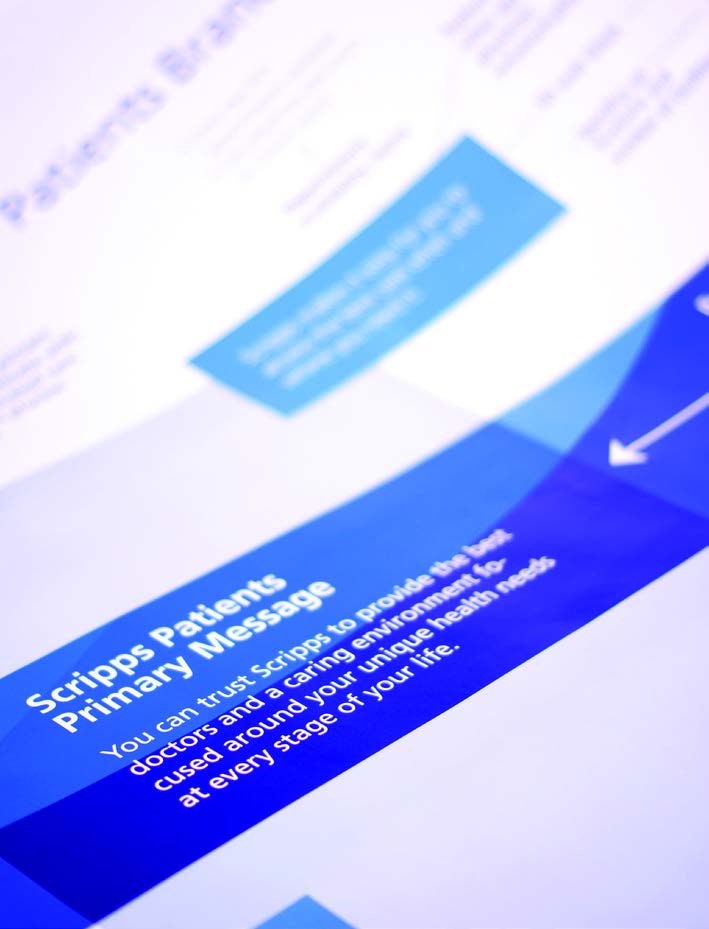The goal? “To create unparalleled brand recognition and generate an innate understanding of Scripps’ value with healthcare consumers, physicians, donors, and other key audiences,” says Christine Clay, Senior Director, Brand Strategy and Marketing, Scripps Health, San Diego, CA.
First, goals, vision, strategy, challenges, brand equities, competitive dynamics, brand/name architecture, and positioning were assessed. The assessment found that Scripps lacked a clear center of gravity in its messaging, and that branding had become fragmented and out of sync with the system’s new “One Scripps” focus.
“We knew if we could create synergies by uniting brand elements, we could elevate the Scripps brand and also advance business objectives,” Clay notes. “So, we adopted a clear, focused brand platform, including a new brand promise, positioning, brand pillars, and brand attributes. We developed a new brand architecture and naming system guided by a master brand strategy; introduced a vibrant and engaging design system to ensure clear, consistent expression of our story throughout all touch points; and implemented interactive message maps to ensure on-brand communications. Employee engagement initiatives to ensure delivery of on-brand experiences and a powerful new external communications campaign completed the program.”
Internal Education Builds Engagement
Those employee engagement initiatives, conducted in partnership with Human Resources (HR), were instrumental to the success of the rebranding initiative.
“It was important that we demonstrated that our brand belongs to everyone in the organization—that it is not just the responsibility of the marketing team,” says Don Stanziano, Corporate Vice President of Marketing Communications, Scripps Health. “Working with HR, we are infusing the brand promise and brand platform across the full spectrum of employee-facing programs and initiatives, from new employee orientation and rebranding our employee recognition program to building a new curriculum in our Center for Learning. Most recently—and perhaps most impactful—the brand is at the center of the training program for a new initiative Scripps is implementing to drive operational efficiency.”
“Now, Scripps employees are beginning to use brand in conversations throughout the system and referencing it in potential partner situations as a guide to decision-making,” Stanziano adds.
Rebranding Yields Synergy… and Success
While the rebranding has been a success, the project was not without challenges. For one, preparing for the rollout took longer than expected.  Ultimately though, the delay had a positive effect. “While we would have preferred to launch earlier, the delay allowed us to fully integrate the brand rollout in a new Culture of Excellence patient and employee satisfaction initiative,” reveals Clay.
Ultimately though, the delay had a positive effect. “While we would have preferred to launch earlier, the delay allowed us to fully integrate the brand rollout in a new Culture of Excellence patient and employee satisfaction initiative,” reveals Clay.
Stanziano cautions that marketers also must be prepared for political challenges when rebranding. “Work with an objective outside expert to help navigate the process,” he advises. Also important: using upfront research to shape final solutions and recognizing that a rebrand is much more than a transformation in visual expression. “Successful rebranding requires cultural change and executive buy-in on the value of brand as a strategic asset,” says Stanziano.
With the new, unified Scripps brand, the sum is now truly greater than the individual parts, and the organization is reaping the rewards of system, or synergy, branding. Duplication of efforts in marketing and communications have been reduced while effectiveness has increased. Most importantly, the 124-year tradition of Scripps is more dynamic than ever before—and ready to meet the next challenges in the new era of healthcare.
This article originally appeared in the Healthcare Strategy Alert, 2014, issue 2.



